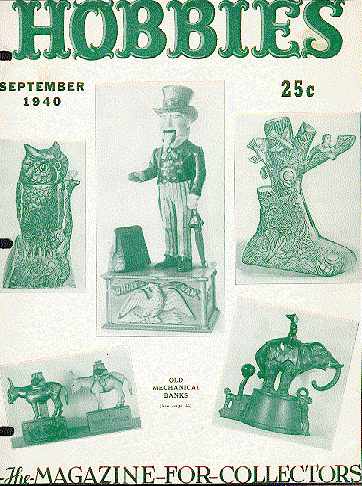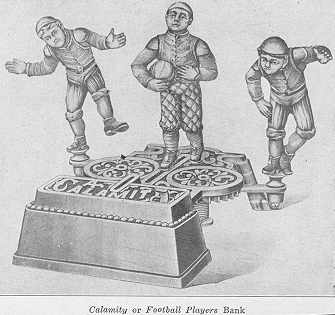HOBBIES — The Magazine for Collectors, September 1940
OLD MECHANICAL BANKS
 THE
first work ever published on the subject of "Old
Mechanical Banks" is just off the press. Ina Hayward Bellows who has
had considerable recognition as an authority on the subject is the author. For
many years she has been a collector, and to an extent, a dealer, in these banks.
THE
first work ever published on the subject of "Old
Mechanical Banks" is just off the press. Ina Hayward Bellows who has
had considerable recognition as an authority on the subject is the author. For
many years she has been a collector, and to an extent, a dealer, in these banks.
Mrs. Bellows has been making research and preparing for a number of years for this book which covers the history of mechanical banks, how and why they were made, and the reasons they became a hobby of collectors.
The illustrations of the various old mechanical banks together with descriptions, variance in manufacture, and values comprise the most valuable part of the book. Mrs. Bellows classifies the banks in various groups and beneath each illustration gives the description and approximate value, making leeway for condition. It was an expensive procedure to obtain pictures and illustrations of so many banks and yet the price of this book is only $2.50. It will be eagerly sought by collectors of mechanical banks and will be of inestimable value to dealers who occasionally pick up these much-sought items. The book will be a credit to any library and as the edition is limited, there will no doubt be a premium on it in future years.
H. A. Ballard, Novato, Calif., has the honor of being the first buyer of Mrs. Bellow's book.
A GREAT many persons in the antiques business today can remember when old mechanical banks had not yet gained their stride. But today there are probably few shops in the country but that have, at least a few, old mechanical banks. You need but ride from shop to shop to be convinced that dealers have rescued interesting old specimens and placed them on display, and many dealers have quite comprehensive stocks due to the increasing demand. Those who have visited the annual Chicago Antiques Expositions and Hobby Fairs have, no doubt, been intrigued by the many different types displayed. Since the bank collecting hobby has come into its stride there seems no indication now that the pace will ever falter.
The bank hobby probably draws its greatest number of devotees from the banking profession. Several outstanding bank executives collect old mechanical banks, and competition is keen among them when a rare old specimen finds its way onto the market for the first time. This group of collectors not only carry on a personal campaign for additions to their collections, but they advertise consistently to make known their wants as the monthly Ads in Hobbies testify. Their influence has had the effect of stabilizing the hobby, so to speak. The average person reasons that if a banker considers the purchase of banks on an ever increasing scale that they must not only be a satisfying hobby but also one in which the values probably never will recede.
 It is not hard to
understand why this group of professional men have had their interest captured by old
mechanical banks. They are an object lesson in the philosophy of thrift. They were
designed originally to lure children into saving a penny or nickel, through an intriguing
mechanical apparatus. For instance, note Calamity or the Foot Ball Player bank which is
pictured here. According to Ina Hayward Bellow’s book on old mechanical banks just
published, when the right and left tackles are in position, you place a coin in the slot
in front of the fullback and press the lever. Imagine if you will, a boy or girl, who
could resist operating a bank of this kind over and over again. A man who remembers the
not so far distant past era of the mechanical bank said he received one for Christmas one
year, and that his father was particularly fascinated by it and that he put more coins
into it than he did.
It is not hard to
understand why this group of professional men have had their interest captured by old
mechanical banks. They are an object lesson in the philosophy of thrift. They were
designed originally to lure children into saving a penny or nickel, through an intriguing
mechanical apparatus. For instance, note Calamity or the Foot Ball Player bank which is
pictured here. According to Ina Hayward Bellow’s book on old mechanical banks just
published, when the right and left tackles are in position, you place a coin in the slot
in front of the fullback and press the lever. Imagine if you will, a boy or girl, who
could resist operating a bank of this kind over and over again. A man who remembers the
not so far distant past era of the mechanical bank said he received one for Christmas one
year, and that his father was particularly fascinated by it and that he put more coins
into it than he did.
While the collecting of mechanical banks gains its greatest number of recruits, it seems, from the banking profession it is a field upon which the other hobbyist are drawing in ever increasing enthusiasm. The circusiana collector will find representations in the old mechanical bank field. Elephant and circus collectors have not completed their types until they have one of the "clowns and elephants" banks (see cover this issue). These little figures actually perform when you drop a penny in the slot.
The donkey enthusiast will find The Forty Niner bank to his liking (also illustrated on the cover of this issue), but he must watch out for fakes, as the mechanical bank has unfortunately came under nefarious hands of the faker. The lighter donkey is a fake and is shown in this connection for the sake of comparison. The dark one is genuine.
The Owl bank illustrated in the same group will appeal to any lover of animals or birds. Good old Uncle Sam (center illustration) should call up a patriotic thought in every American. The bank to Uncle Sam’s right depicts a boy robbing a bird’s nest. It is called the Tree bank. What it lacked in moral suggestions it made up in interesting mechanical functioning and a fine finish.
Toy collectors, too, have to have a few old mechanical banks if their assembly of toys is to be truly representative.
The mechanical penny bank is typical of the era from whence it sprang. It depicts the days of more leisurely living, when there was time for artistic handcraftsmanship and design, when there was appreciation of thrift, and the desire for stability on the part of the parents for their children.
The old mechanical bank designers and manufacturers were agreed on one point — that each should be devoid of a convenient method for removing the coin. Try removing the coin from one of these sometime. It is next to impossible to do without taking the bank apart. The makers couldn't let the thrifty parents down like that.
Just as the Currier & Ives artists depicted events of their day by the engraving process, the old mechanical bank told a historic story in iron banks. Paddy and His Pig is said to be representative of the Irish immigration which reached its zenith in the 80's and 90's; Jonah and the Whale is reminiscent of a period when the religious fervor of our forebears touched on all things connected with life; the English influence in John Bull; there is the political stump speaker of post Civil War days and Uncle Sam with His Carpet Bag. Near the end of the era of mechanical banks is Teddy and the Bear, and the Lion Hunter. Collectors of political material who do not own one of the latter specimens are overlooking an important memento of Theodore Roosevelt.
Each year adds new recruits; competition becomes keener with each year, and certainly these old mechanical banks are carving a niche for themselves in the collecting arts.
